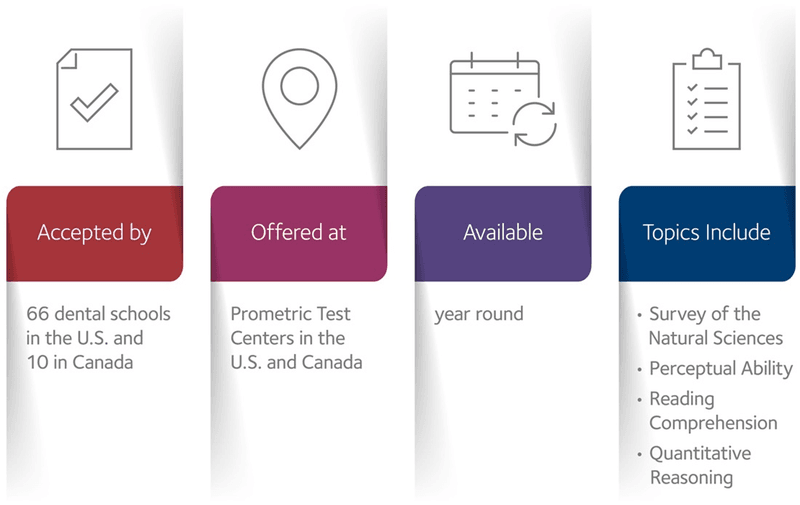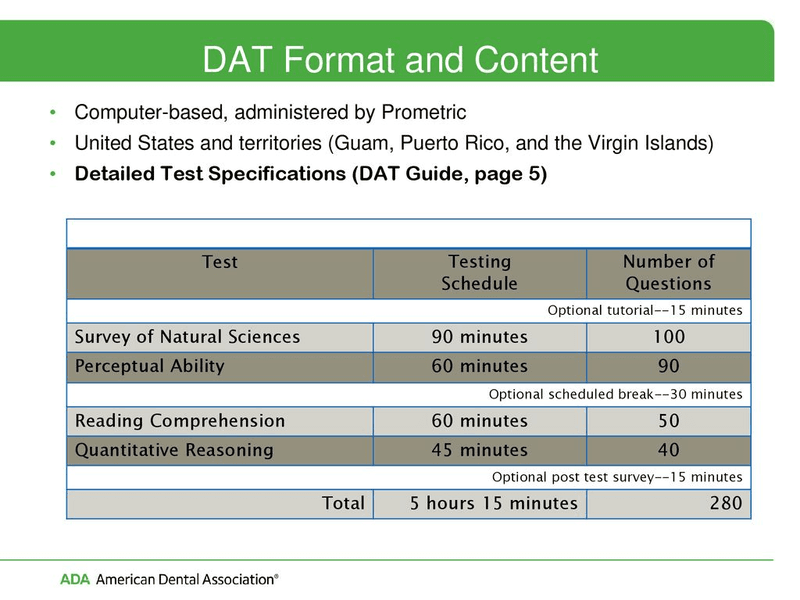You've probably heard of the Dental Admission Test or DAT if you have ever wanted to be a dentist. However, as an international student or otherwise, you might be wondering what the DAT is. The DAT is a multiple-choice entrance exam necessary for acceptance to dental universities in the United States and Canada.

To help you along your journey, we've crafted an ultimate DAT guide for you which covers the following -
The American Dental Association (ADA) governs the Dental Admission Test (DAT). This organization is used to admit students to education programs regarding dentistry in North America (the US & Canada). The test is year-round at several Prometric test sites in Canada and US jurisdictions. This includes Guam, the Virgin Islands, and Puerto Rico. The DAT programs have been in effect for approximately 72 years, established in 1950.
The DAT exam consists of MCQs (multiple-choice questions) in English created and prepared following the specified requirements. The DAT includes questions from four essential sections - Reading Comprehension, Natural Science Survey, Sensory Ability, and Quantitative Aptitude.

Before submitting an application form, ensure that you read the DAT handbook thoroughly and become familiar with the minimum eligibility criteria, application procedure, test structure and content, test results, and policy and guidelines included within.
The following are the minimum qualifications for taking the DAT in 2022 -
Candidates must submit a new application for each retest and pay a fee. In addition, they must wait at least 90 days after their previous try before retaking the exam. It is critical to note that there are no exemptions to the 90-day time frame.
If you have taken the DAT three or more times, you must obtain permission from the ADA to retake the test. In this regard, you must send a written request to [email protected], accompanied with one of the relevant documentation:
It is critical to establish eligibility for DAT 2022 before applying. You must receive a DENTPIN to sit for the DAT or request admittance to a dental school (Dental Personal Identification Number).
You must submit a new DAT application form after receiving a DENTPIN by browsing ADA.org/DAT. Please remember that the info you provide in the application must be correct.

If you intend to make any changes to your application, you must do so at least two weeks before your appointed test date. For relevant revisions, don't hesitate to contact the Department of Testing Services at [email protected]. If you change your contact details, such as your address or email address, by utilizing the "Update Your DENTPIN®" function at ADA.org/DENTPIN, bear in mind that any previous applications and score reports will not be immediately updated.
During the testing phase, you must supply the Department of Testing Services with your info, such as your name, date of birth, DENTPIN, residence, and other information needed. Your results will be impacted if any of the submitted information is incorrect.
When your application is processed correctly, you will receive an email from the Department of Testing Services with scheduling guidelines. You must also call 800.688.5804 or go to Prometric.com to make an appointment to take the DAT.
You can get the same information by calling 800.688.5804 or visiting Prometric.com. Your appointment cannot be scheduled, rescheduled, or cancelled at the regional test centre. Please remember that your appointment must be cancelled at least 24 hours in advance.
The DAT is entirely digitally conducted. Throughout the exam, a countdown timer appears on the lower right side of the screen. You will not be permitted to wear a watch or have access to a clock. There will be one 30-minute rest break designated during the examination, but you may take extra breaks with the proctor's approval. However, the test timer will keep running. Therefore, even if you are not in front of the computer, the exam will continue to run, and subsequent sessions will begin immediately if the time for the preceding portion has elapsed.
The Survey of Natural Sciences segment has an on-screen periodic table, while the Quantitative Reasoning section includes an on-screen calculator. The testing centre supplies a noticeboard and a marker for note-taking and writing down computations. You may not bring your equipment, writing tools & calculators, or paper to class.
The DAT is ultimately an endurance test that is divided into four sections and has 280 multiple-choice questions. It may be a trying experience. If you do not prepare for the DAT with enough conviction and energy, you may lose your cool on test day. That is why effective management of the test is critical.

The DAT consists of four timed sections: Survey of Natural Sciences (which includes Biology, General Chemistry, and Organic Chemistry), Perceptual Ability, Reading Comprehension, and lastly Quantitative Reasoning.
The Survey of Natural Sciences part assesses your understanding of university-level sciences. There are 100 multiple-choice questions in each of the three sections: Biology, General Chemistry, and Organic Chemistry. The portion lasts 90 minutes, leaving you only 54 seconds to answer each question.
The following is the distribution of Survey of Natural Sciences questions - 40 questions in biology, 30 in general chemistry, and 30 in organic chemistry.
The Perceptual Ability segment lasts 60 minutes and consists of 90 multiple-choice questions, with 40 seconds to answer each. Your capacity to mentally see and understand objects in three dimensions, as well as your angle recognition skills, will be examined here.
You'll have 60 minutes to read three passages (giving you approximately 20 minutes to go through each). Questions will assess your ability to understand, evaluate, and characterize passages on a wide range of scientific issues. There are a total of 50 multiple-choice Reading Comp questions. If international students are concerned about their English language understanding, they may need to study this part.
The Quantitative Reasoning part lasts 45 minutes and consists of 40 multiple-choice questions, with a little more than a minute to answer each one.

The math concepts will be tested on the following -
DAT test takers are assigned one of eight standard scores ranging from 1 to 30. Your raw score is determined by the number of multiple-choice questions you successfully answer in each segment of the test. There is no penalty for erroneous responses, and all multiple-choice questions are worth one point each, regardless of inherent difficulty or complexity. That implies you must always complete an answer for each question, regardless of whether you have time to devote to it entirely. Never let a section's time limit expire without answering all of the questions.
Your raw score is just the number of questions answered correctly in each segment. Because it does not represent the relative performance of all examinees, this score is not the signal of your ability that schools get. As a result, you and the institutions you are pursuing will obtain a scaled score in the 1-30 range on the formal DAT score report.
You can calibrate each exam for group performance and complexity using equating processes by converting your raw score to a scaled score. For example, a score of 17 on the scale represents representative or nearly average performance. This enables dental schools to evaluate results from various tests of potentially varying difficulty objectively.
Now, we understand if you feel pretty intimidated by the DAT test. It is quite expansive and will require you to work immensely hard to achieve your desired results. But, do not be disheartened and shy away from your goals. If you need help with your DAT prep, DAT Prep is all you need.

Over the years, DAT Prep has accumulated data from thousands of students to learn and study more effectively. We will assist you in focusing on the most challenging and demanding materials immediately before the exam while also ensuring that you study any topics you may have forgotten. Moreover, you can study for your test through your phones for convenience and receive detailed analytics assessing your preparation.